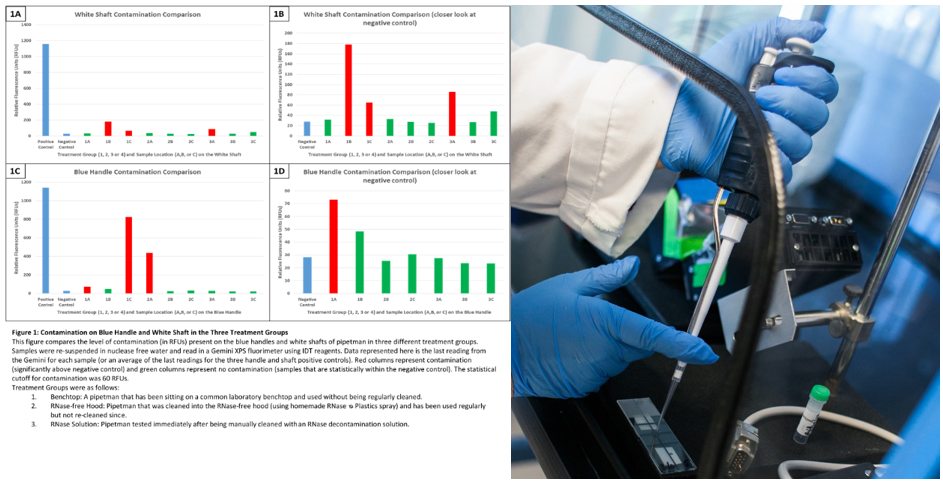Previous research has shown that KeyProTM (Phoseon Technology) rapidly and reliably decontaminates laboratory pipetman (1, 2). The unanswered question is, how necessary is this decontamination? Here we present a quantification of the contamination burden residing on pipetman and how effective the current preventative measures are. You’ll be surprised!
What we know from experience
We know that clean pipettes are paramount to reliable results. And while this standard is expected from any molecular biology lab. Here is what experience tells us:
Contaminants such as viruses, nucleic acids, bacteria and more can come from the most unlikely of places.
What we proved
About Pipette contamination
In our three-group test (see Figure 1) we found:
- 4 out of the 6 locations sampled in a pipette left on an open benchtop were contaminated (65 to 825 RFUs). Your pipettes are not clean!
- The most contaminated sample was in the ejector button of the blue handle, which tells us that contamination is concentrated (Figure 1C).
About common decontamination methods
- Chemical decontamination is effective but fallible. An RNase decontamination solution was sprayed on the pipettes. While the solution eliminated RNase contamination as expected, it was subject to human error in whipping technique (sample 3A in Figure 1B).
- Even without human error, it is still possible for equipment to become contaminated. We tested a pipette that had been previously well-cleaned into the RNase-free hood and remained there for multiple days. Here we see sample 2A of the handle (Figure 1C) showing an RFU of 438. This significant level of contamination could potentially be a result of human error in chemically cleaning pipettes; or, more ominously, it might also indicate fallibility of the RNase-free hood. Whether this pipette was improperly cleaned into the hood or contamination was realized while in the hood, the fact remains this hood can no longer be trusted. A problematic finding when operating under the assumption that all equipment and surfaces in the hood are RNase-free.

While it is intuitively known that contamination can happen fast and often it has not been known to what degree, particularly when common preventative measures are taken. Here we have shown that even the most common preventative measures (chemical decontamination and hood protection) cannot stop all contamination. Imperfect cleaning or minor changes in airflow contamination can ruin runs. As a possible solution we suggest KeyProTM (Phoseon Technology).

Previous testing with KeyProTM has shown that solid-state UV-LEDs present an efficient, reliable method of decontaminating laboratory equipment without erosion, human error, or the fear of unpredictable contamination.
Though we cannot always prevent contaminants from tainting laboratory equipment, there is a solution: KeyProTM.
Contact us for more information and update your laboratory equipment now!
Check out these articles about pipette disinfection using Keypro:
Decontamination of Gilson® Pipettes Using High
Intensity UV LED
Decontamination of Gilson® Pipettes Using High
Intensity UV LED (part 2)
Click here to see the full experiment report on pipette disinfection


